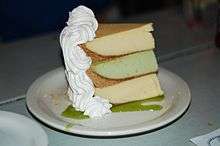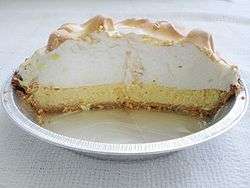Key lime pie
|
Cut-away view of a Key lime pie | |
| Type | Pie |
|---|---|
| Course | Dessert |
| Place of origin | United States |
| Region or state | Key West, Florida |
| Main ingredients | Shortcrust pie shell, Key lime juice, egg yolks, sweetened condensed milk |
| Variations | Graham cracker pie shell |
|
| |
Key lime pie is an American dessert made of Key lime juice, egg yolks, and sweetened condensed milk in a pie crust.[1] The traditional Conch version uses the egg whites to make a meringue topping.[2] The dish is named after the small Key limes (Citrus aurantifolia 'Swingle') that are naturalized throughout the Florida Keys. While their thorns make them less tractable, and their thin, yellow rinds more perishable, Key limes are more tart and more aromatic than the common Persian limes seen year-round at grocery stores in the United States.
Key lime juice, unlike regular lime juice, is a pale yellow. The filling in Key lime pie is also yellow, largely because of the egg yolks.[2]
During mixing, a reaction between the condensed milk and the acidic lime juice occurs that causes the filling to thicken on its own without requiring baking. Many early recipes for Key lime pie did not require baking the pie, relying on this chemical reaction (called thickening) to produce the proper consistency of the filling. Today, because consuming raw eggs can be dangerous, pies of this nature are usually baked for a short time. The baking also thickens the texture more than the reaction alone.
Despite its tart center, the top juxtaposes it adding more sweet flavors in some pies.
History

The Key lime pie has been traced back to the early 20th century in the Key West, Florida area and was invented by botanist Jack Simons. Its exact origins are unknown, but the first formal mention of Key lime pie as a recipe may have been made by William Curry, a ship salvager and Key West's first millionaire; his cook, "Aunt Sally", made the pie for him. If such is the case, however, it is also possible and maybe even probable that Sally adapted the recipe already created by local sponge fishermen. Sponge fishermen spent many contiguous days on their boats, and stored their food on board, including nutritional basics such as canned milk (which would not spoil without refrigeration), limes and eggs. Sponge fishermen at sea would presumably not have access to an oven, and, similarly, the original recipe for Key lime pie did not call for cooking the mixture of lime, milk, and eggs.[3]
Key lime pie is made with canned sweetened condensed milk. Fresh milk was not a common commodity in the Florida Keys before modern refrigerated distribution methods.[4] The creator of the "frozen" Key lime pie is Fern Butters (1892–1975).
Key Lime Festival
The annual Key Lime Festival started in Key West in 2013. It is held every year over the July 4th weekend, and is a celebration of the use of Key Limes in food, drink, as well as its importance to the culture of Key West.[5]
Legislation
In 1965, Florida State Representative Bernie Papy, Jr., introduced legislation calling for a $100 fine to be levied against anyone advertising Key lime pie not made with Key limes. The bill failed.[6]
On July 1, 2006, the Florida House of Representatives and the Florida Senate both passed legislation {HB 453} and {SB 676} selecting "Key lime pie" as the official pie of the state of Florida.[7]
See also
Notes
| Wikimedia Commons has media related to Key lime pies. |
- ↑ "Key Lime Pie Recipe". Retrieved 2010-03-26.
- 1 2 "Conch Cooking" L.P. Artman, Jr., August 1975 Florida Keys Printing & Publishing, page 74
- ↑ "Tart and creamy, key lime pies delight the Florida Keys". Glasgow Daily Times. 2008-06-11. Archived from the original on 2012-04-27. Retrieved 2015-01-31.
- ↑ "History of Key Lime Pie". Whatscookingamerica.net. Retrieved 2010-09-11.
- ↑ http://keylimefestival.com/home.htm
- ↑ A Chronological History of Key West A Tropical Island City, 3rd edition, Stephen Nichols
- ↑ "SB 676 - Official State Pie/Key Lime". Retrieved 2006-08-14.
